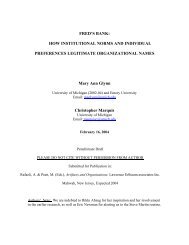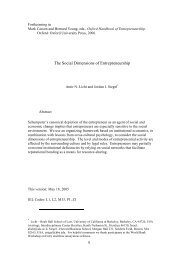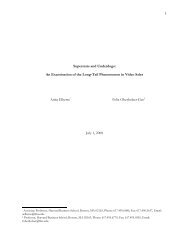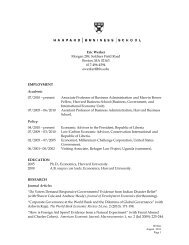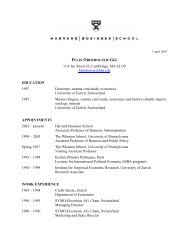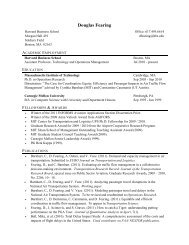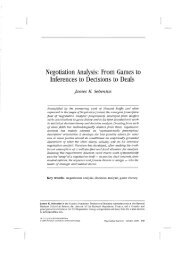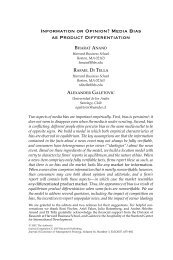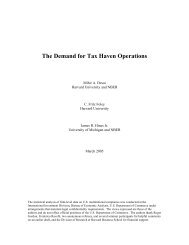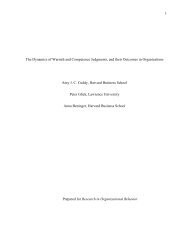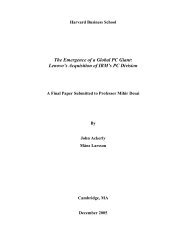A Note on Valuation Models: CCFs vs. APV vs WACC - Harvard ...
A Note on Valuation Models: CCFs vs. APV vs WACC - Harvard ...
A Note on Valuation Models: CCFs vs. APV vs WACC - Harvard ...
You also want an ePaper? Increase the reach of your titles
YUMPU automatically turns print PDFs into web optimized ePapers that Google loves.
Numerical Example<br />
Table 1 shows the financial assumpti<strong>on</strong>s underlying our numerical example. The firm is valued<br />
over a period of 5 years during which EBIT is growing at 5% per annum and depreciati<strong>on</strong>,<br />
capital expenditure and increase in working capital are c<strong>on</strong>stant. However the firm’s capital<br />
structure changes significantly through the repayment of a major porti<strong>on</strong> of its debt.<br />
Table 1: Assumpti<strong>on</strong>s (in €)<br />
Year 1 Year 2 Year 3 Year 4 Year 5<br />
Risk Free Rate 5% 5% 5% 5% 5%<br />
Market Risk Premium 7% 7% 7% 7% 7%<br />
Tax Rate 40% 40% 40% 40% 40%<br />
Asset Beta 1.2 1.2 1.2 1.2 1.2<br />
Debt Beta 0.4 0.35 0.3 0.25 0.2<br />
EBIT 100,000 105,000 110,250 115,763 121,551<br />
Depreciati<strong>on</strong> 50,000 50,000 50,000 50,000 50,000<br />
Capex 60,000 60,000 60,000 60,000 60,000<br />
Increase in NWC 10,000 10,000 10,000 10,000 10,000<br />
Debt 100,000 50,000 25,000 12,500 6,250<br />
We will start valuing the firm using the <strong>WACC</strong> approach (see table 2). This is the less<br />
appropriated and most complex methodology given the forecasted changes in capital structure.<br />
Indeed the <strong>WACC</strong> needs to be recalculated every year and an iterative calculati<strong>on</strong> has to be used<br />
since the value of the firm for each year is required to derive the percentage of debt and equity.<br />
The firm value in year N is the value of the remaining cash flows. For instance the value of the<br />
firm at the beginning of Year 3 is the value of the remaining cash flow in Year 3, 4 and 5<br />
discounted using the <strong>WACC</strong> in year 3, 4 and 5.<br />
Table 2: <strong>WACC</strong> Valuati<strong>on</strong> (in €)<br />
Year 1 Year 2 Year 3 Year 4 Year 5<br />
EBIT 100,000 105,000 110,250 115,763 121,551<br />
- Taxes <strong>on</strong> EBIT (40,000) (42,000) (44,100) (46,305) (48,620)<br />
= EBIAT 60,000 63,000 66,150 69,458 72,930<br />
+ Depreciati<strong>on</strong> 50,000 50,000 50,000 50,000 50,000<br />
- Capex (60,000) (60,000) (60,000) (60,000) (60,000)<br />
- Increase in NWC (10,000) (10,000) (10,000) (10,000) (10,000)<br />
= FCF 40,000 43,000 46,150 49,458 52,930<br />
Percent Debt 61.3% 35.2% 21.5% 14.7% 13.3%<br />
Cost of Debt 7.8% 7.5% 7.1% 6.8% 6.4%<br />
After Tax Cost of Debt 4.7% 4.5% 4.3% 4.1% 3.8%<br />
Percent Equity 38.7% 64.8% 78.5% 85.3% 86.7%<br />
Return <strong>on</strong> Assets 13.4% 13.4% 13.4% 13.4% 13.4%<br />
Cost of Equity 22.3% 16.6% 15.1% 14.5% 14.5%<br />
<strong>WACC</strong> 11.5% 12.4% 12.8% 13.0% 13.1%<br />
Discount Factor 0.90 0.80 0.71 0.63 0.55<br />
PV 35,878 34,329 32,666 30,979 29,325<br />
Firm Value 163,178 141,923 116,451 85,196 46,817<br />
Fabrice Bienfait IFM Final Paper Page 5 of 8



